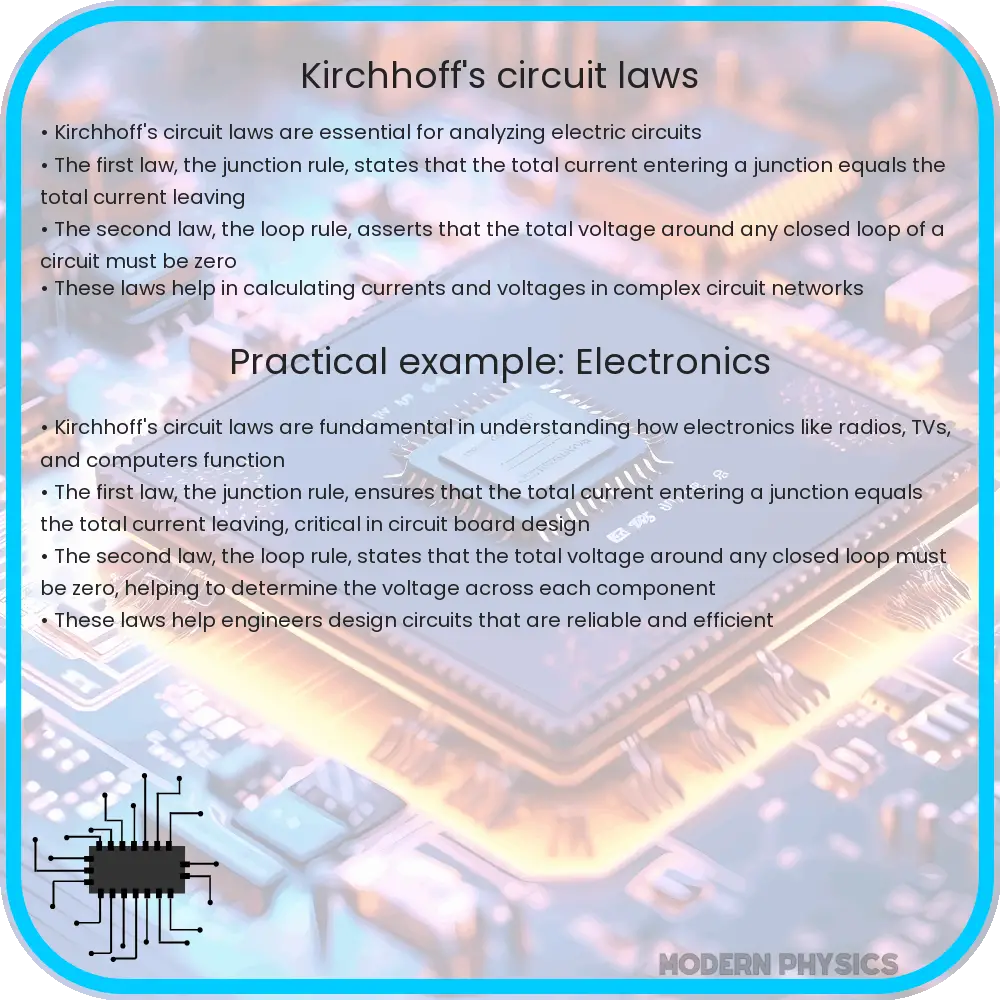Explore Kirchhoff’s Circuit Laws: Learn the principles of KCL and KVL for effective electrical circuit analysis and their practical applications.

Kirchhoff’s Circuit Laws: Unraveling the Fundamentals of Electrical Circuits
Understanding the principles of electrical circuits is crucial in the field of electronics and electrical engineering. Central to this understanding are Kirchhoff’s Circuit Laws, formulated by Gustav Kirchhoff in the mid-19th century. These laws provide the foundational tools for analyzing complex electrical circuits and are indispensable in both theoretical and practical applications.
Principle of Kirchhoff’s Current Law (KCL)
The first of these laws is the Kirchhoff’s Current Law (KCL), which is based on the principle of conservation of electric charge. It states that the total current entering a junction or node in an electrical circuit must equal the total current leaving the node. Mathematically, this can be expressed as:
\(\sum_{k=1}^{n} I_k = 0\)
where \(I_k\) represents the current of the \(k^{th}\) branch connected to the node. This law is pivotal in analyzing circuit behavior, particularly in complex networks with multiple branching points.
Principle of Kirchhoff’s Voltage Law (KVL)
The second law, Kirchhoff’s Voltage Law (KVL), is based on the conservation of energy principle. It states that the total sum of all voltages around any closed loop in a circuit must be zero. In a loop with various elements like resistors, capacitors, and power sources, the algebraic sum of all the voltages must equal to zero:
\(\sum_{k=1}^{n} V_k = 0\)
where \(V_k\) is the voltage across the \(k^{th}\) element in the loop. KVL is instrumental in determining the voltage drops and rises in a circuit loop, thereby enabling the calculation of unknown voltages in the circuit.
Applications in Circuit Analysis
Kirchhoff’s Laws are vital in the analysis of electrical circuits, especially in determining the current and voltage in various parts of a network. They are used extensively in troubleshooting, designing, and understanding both simple and complex circuit systems. These laws also serve as the foundation for more advanced concepts in electronics, such as network theorems and digital circuit design.
In practical applications, Kirchhoff’s Laws are employed in a wide range of scenarios, from simple circuits in educational settings to complex systems in industrial electronics. Their universality and simplicity make them an essential tool for anyone dealing with electrical circuitry.
Understanding and applying Kirchhoff’s Laws require a fundamental grasp of electrical concepts such as voltage, current, and resistance, along with a methodical approach to solving circuit problems. By breaking down complex networks into simpler components and applying these laws, one can effectively analyze and understand the behavior of electrical circuits.
Advanced Techniques in Kirchhoff’s Law Application
While Kirchhoff’s Laws provide a fundamental approach to circuit analysis, their application can be enhanced by integrating them with other analytical techniques. For instance, combining Kirchhoff’s Voltage Law (KVL) with Ohm’s Law allows for the effective calculation of unknown values in a circuit, such as resistance, current, and voltage. Additionally, these laws are integral to the Mesh Analysis and Nodal Analysis techniques, which are systematic methods for analyzing complex circuits.
Mesh and Nodal Analysis
In Mesh Analysis, which applies KVL, circuits are broken down into loops (or meshes), and the voltage around each loop is calculated to determine the current flowing through each component. Nodal Analysis, leveraging KCL, involves identifying nodes in the circuit and calculating the voltage at these points to find the current flow. These methods, rooted in Kirchhoff’s Laws, are particularly useful for circuits with multiple components and pathways.
Limitations and Considerations
While Kirchhoff’s Laws are widely applicable, they do have limitations. These laws assume ideal conditions – no energy loss in wires, perfect conductors, and instantaneous signal propagation. In real-world applications, factors like wire resistance, inductance, and capacitance can introduce discrepancies. Therefore, for high-frequency or very large circuits, more complex models and theories may be required to accurately predict circuit behavior.
Conclusion
Kirchhoff’s Circuit Laws, comprising the Current Law (KCL) and the Voltage Law (KVL), remain fundamental in the field of electrical engineering and electronics. They offer a basic yet powerful framework for analyzing and understanding the behavior of electrical circuits. Whether it’s a simple circuit in a classroom or a complex network in a high-tech industry, Kirchhoff’s Laws provide the essential tools for diagnosis, design, and innovation. As technology evolves, these laws continue to be relevant, underpinning more advanced theories and applications in circuit analysis. Their simplicity and universality not only make them an indispensable part of electrical engineering education but also a cornerstone in the ongoing development of electronic technologies.
Ultimately, Kirchhoff’s Laws illustrate the beauty and efficiency of applying fundamental scientific principles to solve complex real-world problems. Their enduring relevance is a testament to the ingenuity of Gustav Kirchhoff and the enduring power of fundamental scientific principles in driving technological advancement.
